Why you can trust Tom’s HardwareOur expert reviewers spend hours testing and comparing products and services so you can choose the best for you.Find out more about how we test.
2TB Performance Results
Comparison Products
The Corsair MP600 Elite enters a market that already has a lot of competition. This includes the Maxio MAP1602-basedTeamgroup MP44andHP FX700as well as many drives that share that hardware, such as the Patriot Viper VP4300 Lite. There’s also the Phison E25-basedCrucial T500, which has DRAM and has quickly become a popular drive at 2TB. We also have our best performing drives in theSolidigm P44 Pro, theSamsung 990 Pro, and theWD Black SN850X.
Drives that are more threatened are those built on licensed controllers with less-efficient eight-channel controllers. This includes the InnoGrit IG5236-basedAcer Predator GM7000, the Phison E18-basedCorsair MP600 Pro XTandMP600 Pro LPX, and the SMI SM2264-basedAdata Legend 960 Max. Lastly, to give an idea of PCIe 5.0 performance, we have the high-scoringCrucial T700.
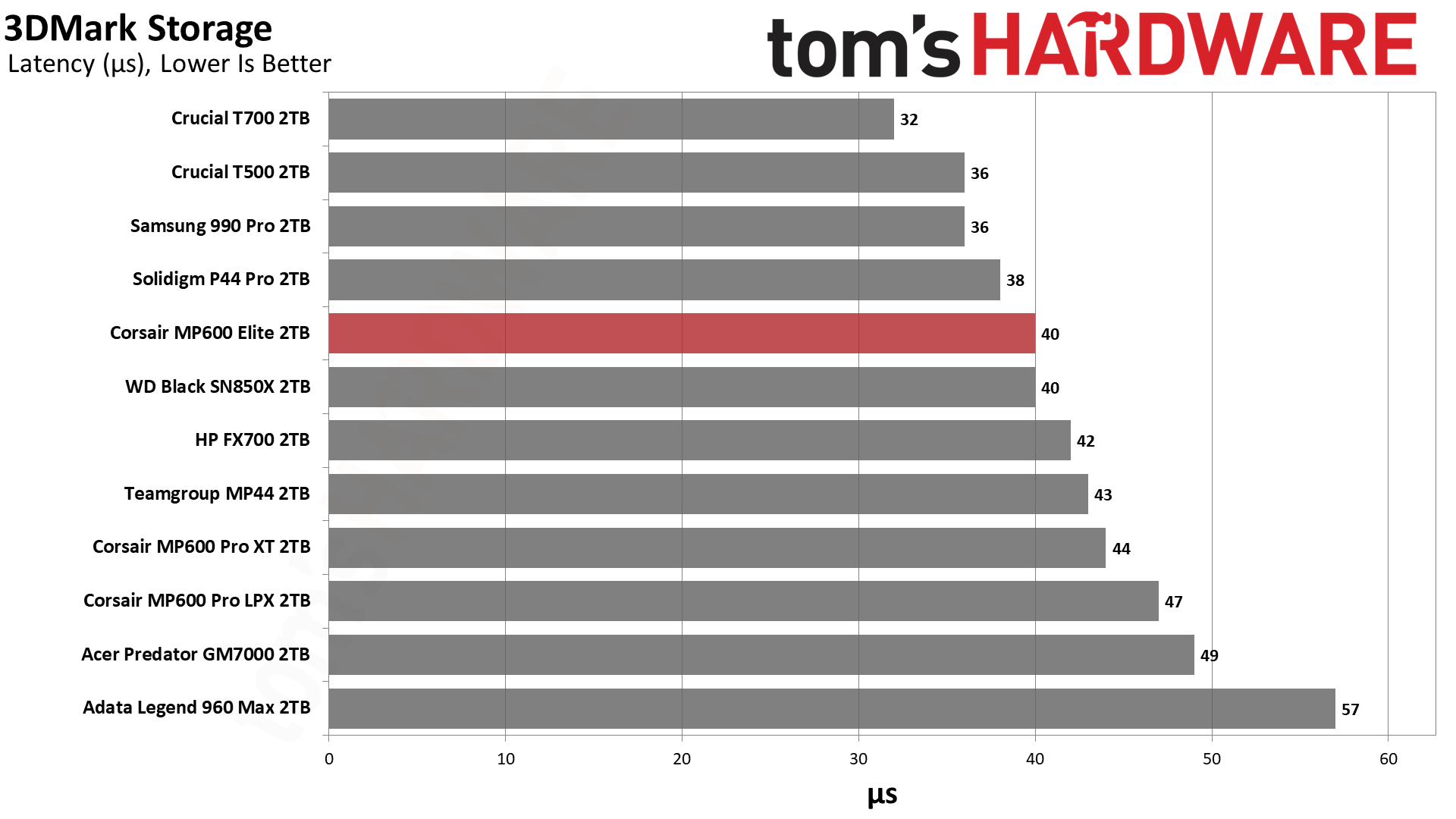
Trace Testing — 3DMark Storage Benchmark
Built for gamers, 3DMark’s Storage Benchmark focuses on real-world gaming performance. Each round in this benchmark stresses storage based on gaming activities including loading games, saving progress, installing game files, and recording gameplay video streams. Future gaming benchmarks will be DirectStorage-inclusive and we include details of that where possible.
The MP600 Elite does pretty well in 3DMark, all things considered. While it is in the middle of the pack, matching the SN850X is certainly worthy of some praise. The drive performs favorably in comparison to the MAP1602-based MP44, as tested, and FX700. The 232-Layer flash and DRAM on the T500, however, help it pull well ahead of the MP600 Elite.
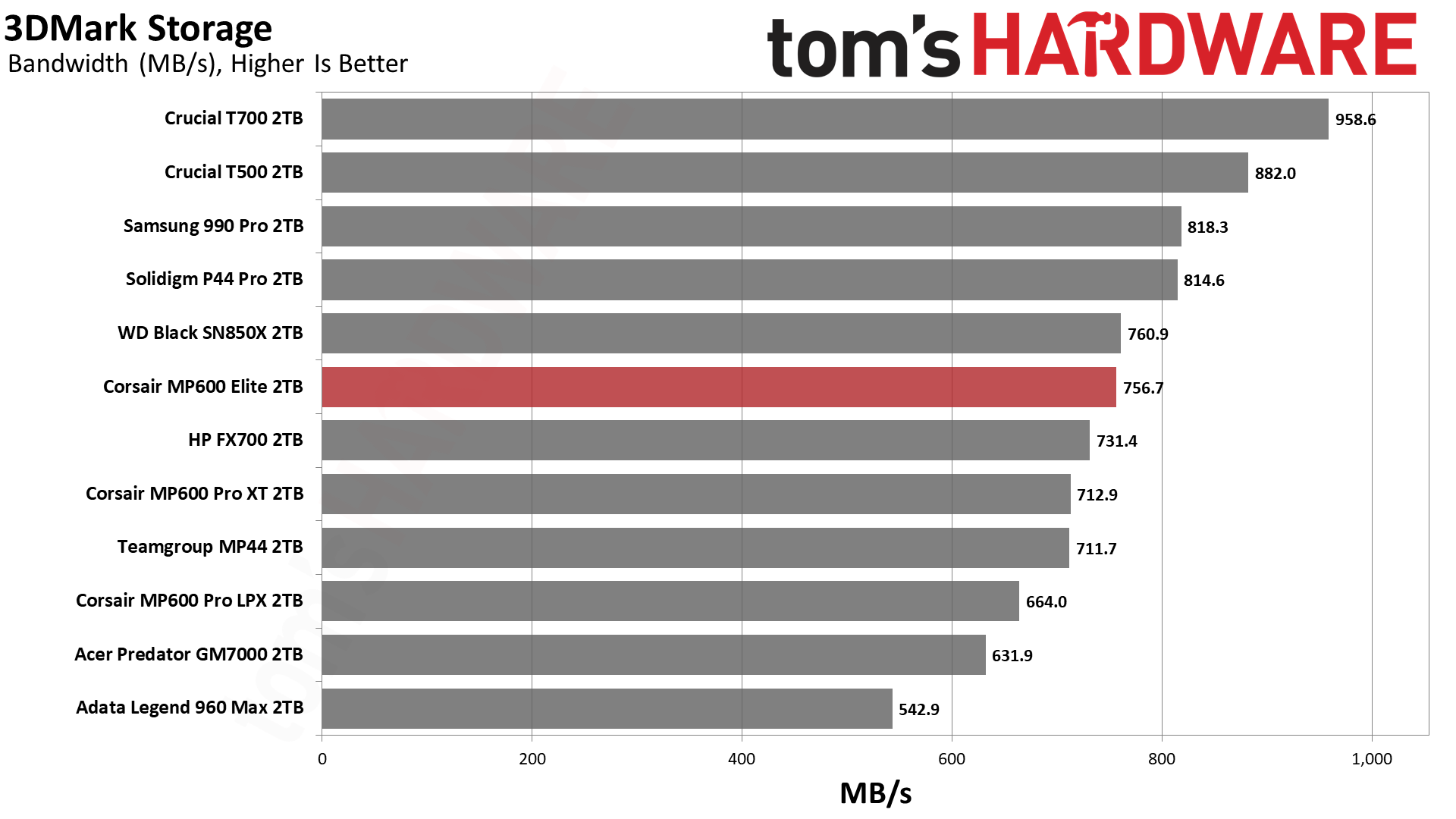
The T500 also has firmware optimization for DirectStorage, something so far only found on DRAM-equipped drives and mostly Gen 5. Corsair intends to add some firmware optimizations for DirectStorage to the DRAM-less MP600 Elite not too long after release, which might help this and similar drives stand out a little bit more.
Trace Testing — PCMark 10 Storage Benchmark
PCMark 10 is a trace-based benchmark that uses a wide-ranging set of real-world traces from popular applications and everyday tasks to measure the performance of storage devices.
The MP600 Elite is once again in the middle of the pack, performing close to the MP44. The T500 is again able to perform much better, though, thanks to its robust hardware.
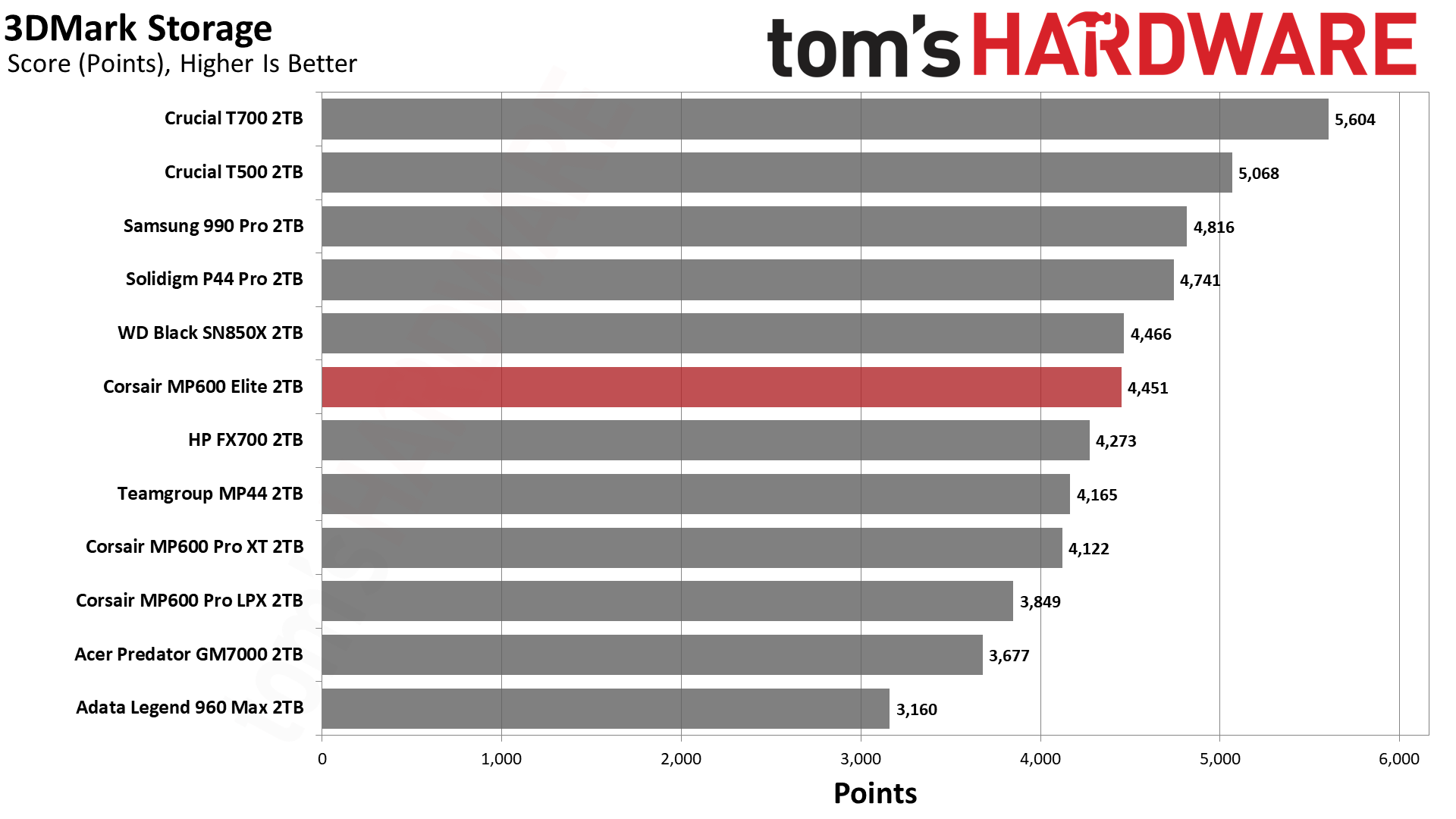
Console Testing — PlayStation 5 Transfers
The PlayStation 5 is capable of taking one additional PCIe 4.0 or faster SSD for extra game storage, with some requirements. Launch models could not take 8TB drives but this limit has since been removed. While any 4.0 drive will work, Sony specifies drives that can deliver at least 5,500 MB/s of sequential read bandwidth are optimal. The PS5 does not support the host memory buffer (HMB) feature but DRAM-less drives will still work. In our testing, PCIe 5.0 SSDs performed irregularly and should not be used in the PS5, especially as they may require additional cooling. Please see ourBest PS5 SSDsarticle for more information.
Our testing utilizes the PS5’s internal storage test and manual read/write tests with over 192GB of data both from and to the internal storage. Throttling is prevented where possible to see how each drive operates under ideal conditions.
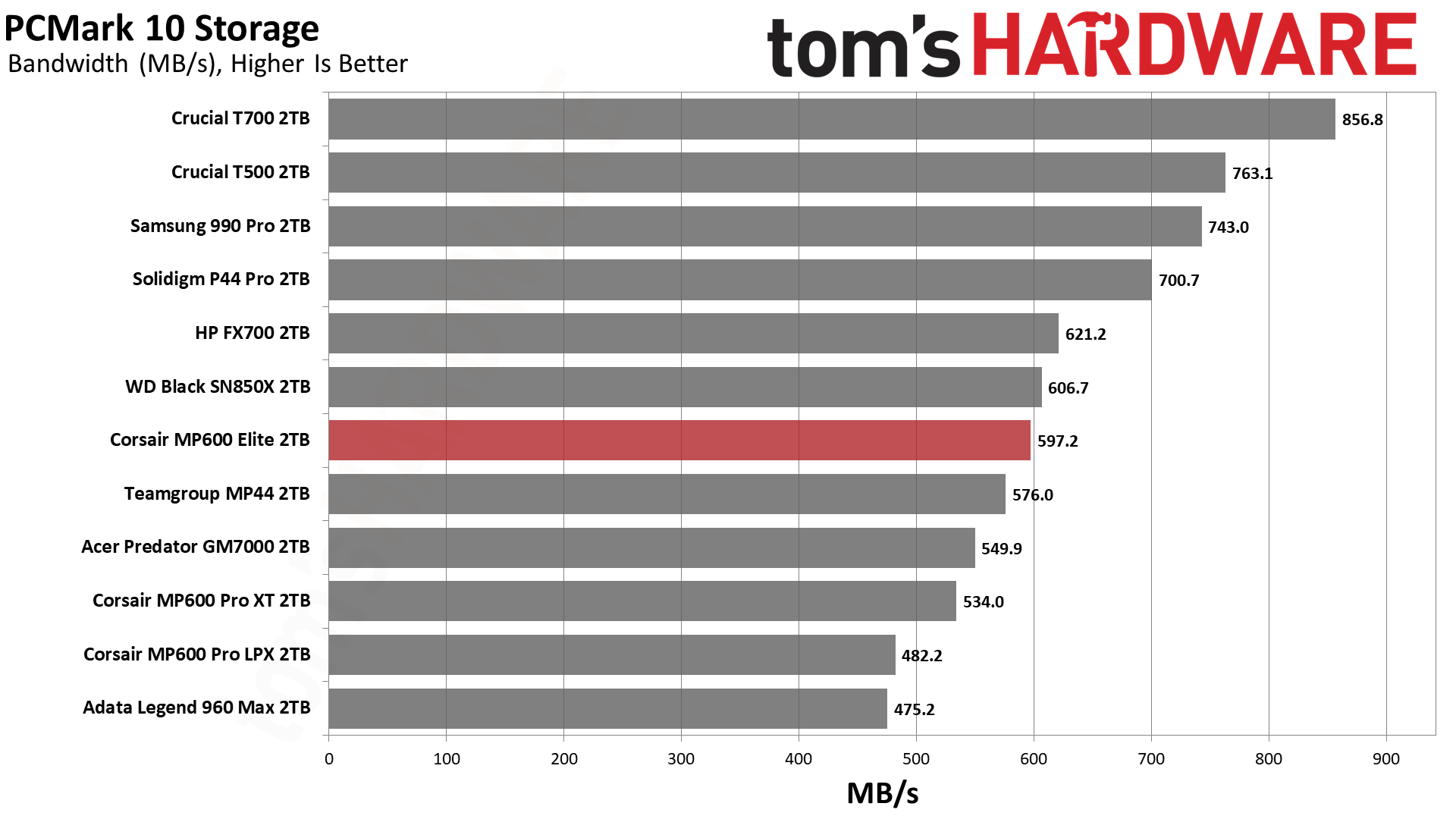
Most drives perform within a narrow range for the PS5, given the limitations of the system workloads. The MP600 Elite does fall behind with the PS5 destination transfer test, though. This might seem out of place, but it’s due to the drive’s relatively small pSLC cache. This can be beneficial in some cases where you favor sustained transfers or want greater consistency over different fill rates. In any case, we think the MP600 Elite is still a good choice for a PS5 drive, given the other two results.
Transfer Rates — DiskBench
We use the DiskBench storage benchmarking tool to test file transfer performance with a custom, 50GB dataset. We copy 31,227 files of various types, such as pictures, PDFs, and videos to a new folder and then follow-up with a reading test of a newly-written 6.5GB zip file. This is a real world type workload that fits into the cache of most drives.
The MP600 Elite doesn’t excite in transfers, and it is starting to bump up against its small pSLC cache. Performance is still good enough, but lackluster when compared to the T500. However, the T500 is known for having consistency issues outside of the pSLC cache, so things are not always so clear-cut. The MP600 Elite still puts up numbers close to the SN850X and 990 Pro, so this is by no means disqualifying.
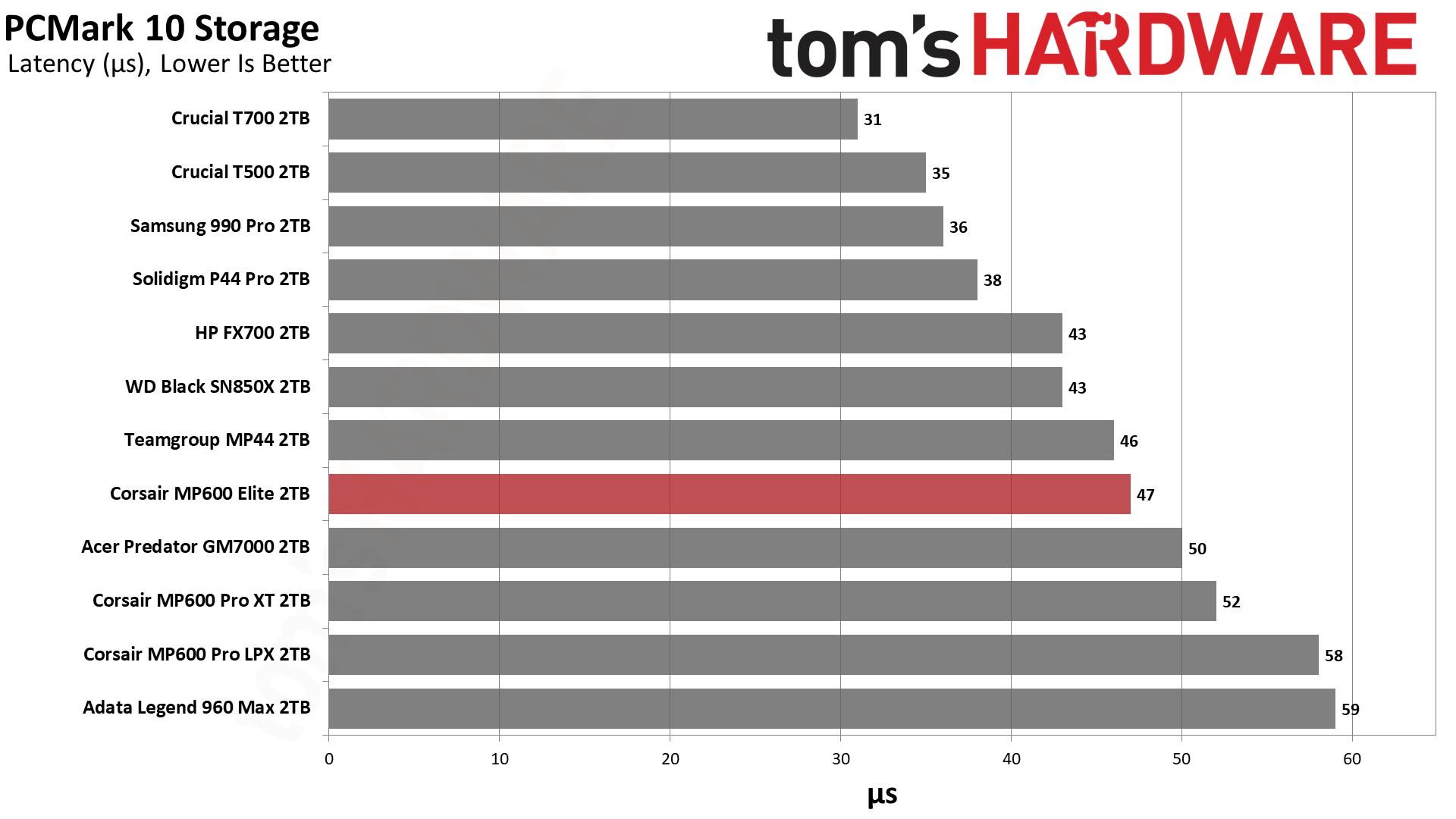
Synthetic Testing — ATTO / CrystalDiskMark
ATTO and CrystalDiskMark (CDM) are free and easy-to-use storage benchmarking tools that SSD vendors commonly use to assign performance specifications to their products. Both of these tools give us insight into how each device handles different file sizes and at different queue depths.
Sequential performance in ATTO is quite good and consistent with weaker results only for writes at the largest block sizes. QD1 sequential performance in CDM is average with some weakness with reads, possibly as a result of the flash being used. On the other hand, random read and write performance at QD1 is excellent, and that’s usually a better predictor of real world feel.
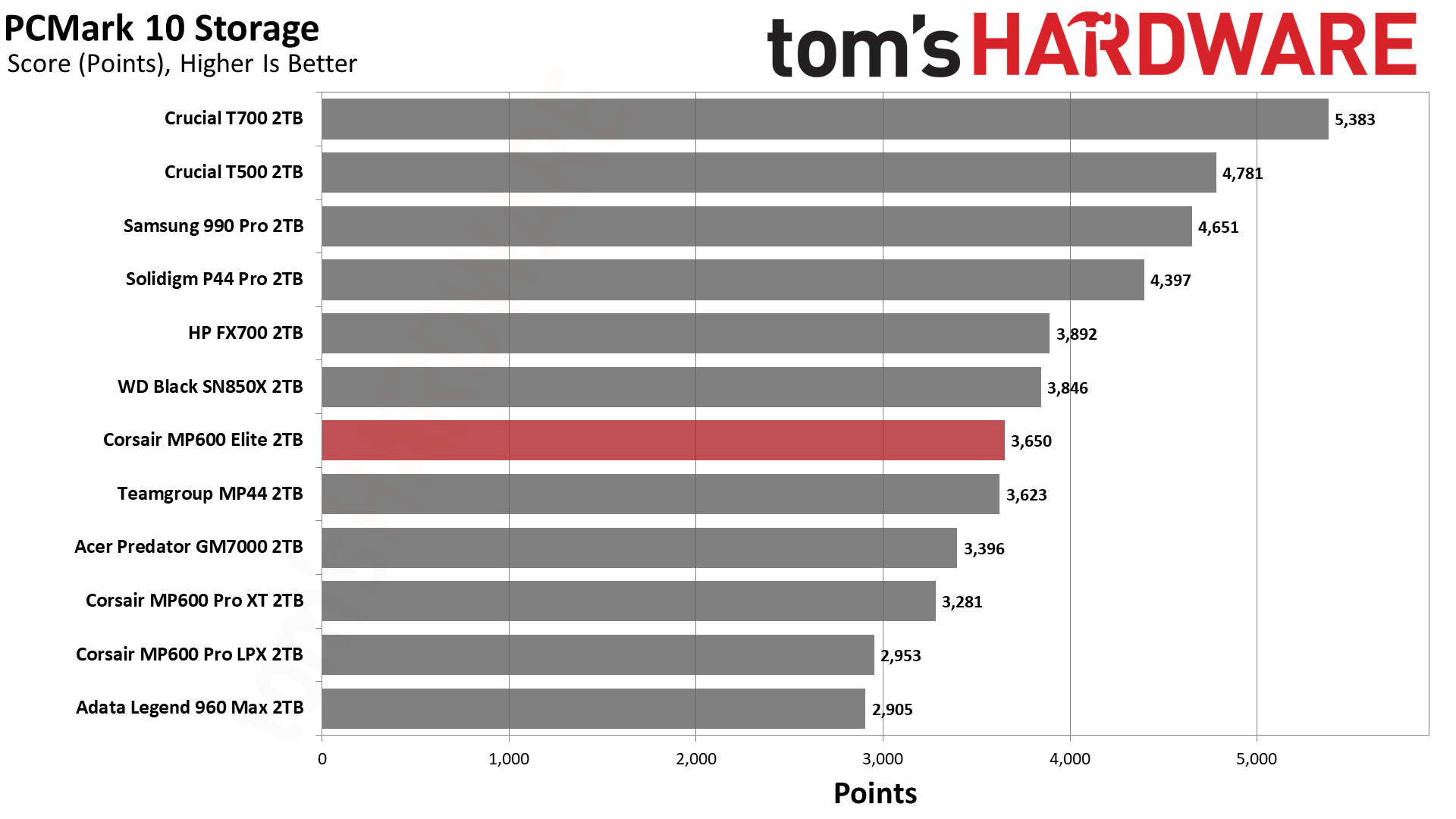
Sustained Write Performance and Cache Recovery
Official write specifications are only part of the performance picture. Most SSDs implement a write cache, which is a fast area of (usually) pseudo-SLC programmed flash that absorbs incoming data. Sustained write speeds can suffer tremendously once the workload spills outside of the cache and into the “native” TLC or QLC flash.
We use Iometer to hammer the SSD with sequential writes for 15 minutes to measure both the size of the write cache and performance after the cache is saturated. We also monitor cache recovery via multiple idle rounds. This process shows the performance of the drive in various states as well as the steady state write performance.
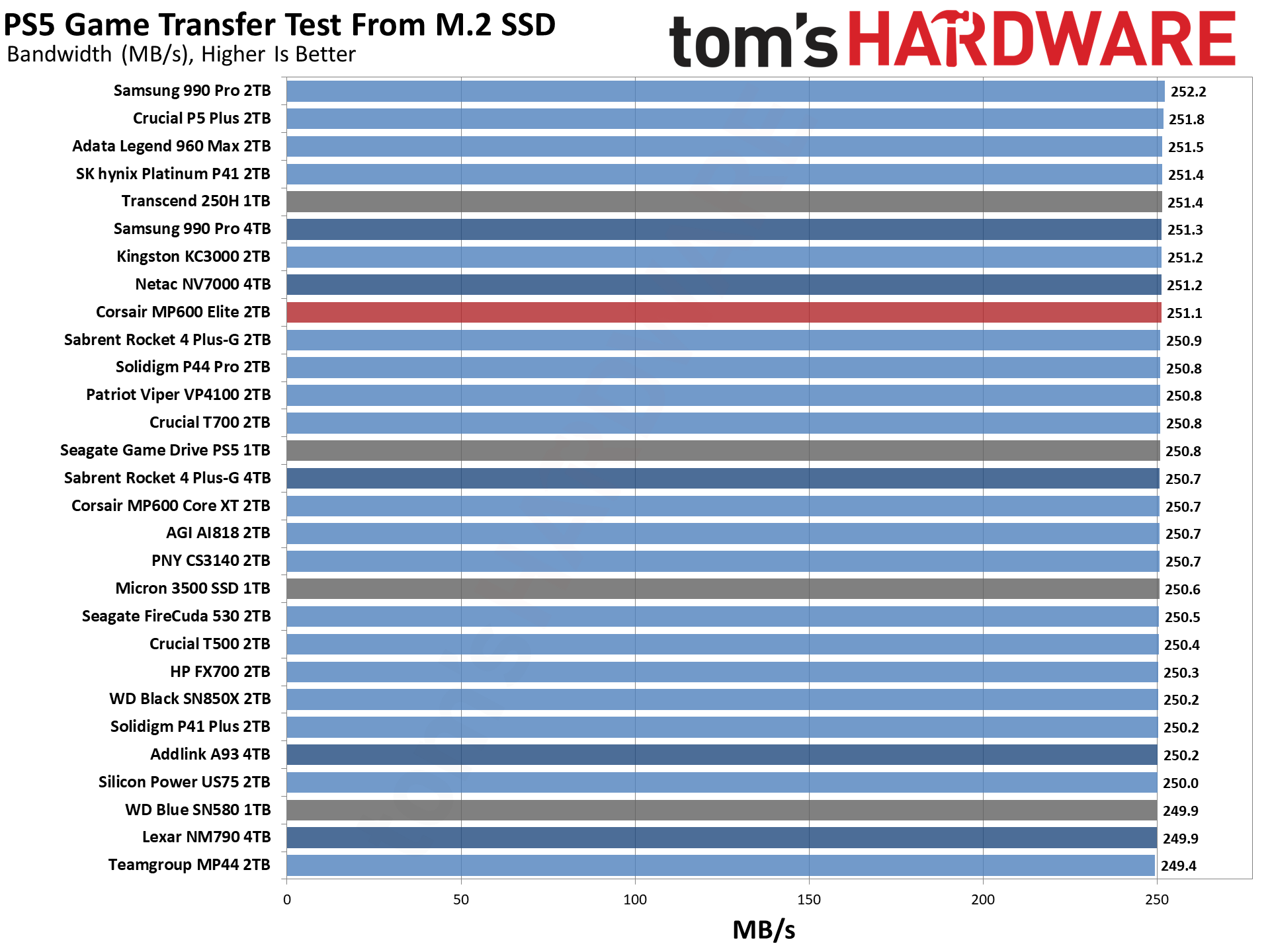
The 2TB MP600 Elite writes at 6.16 GB/s in pSLC mode for just over eight seconds. Therefore, the cache is 50GB, which is small enough that it can impact certain benchmarks. The drive then hits a TLC mode with average write performance hovering around 1.4 GB/s. The cache is small enough that the drive can avoid a slower folding state, and not much recovery time would be necessary to empty the pSLC cache if needed. This dynamic cache will shrink as the drive is filled, but it’s small enough that the impact does not feel as substantial as on drives like the T500.
Power Consumption and Temperature
We use the Quarch HD Programmable Power Module to gain a deeper understanding of power characteristics. Idle power consumption is an important aspect to consider, especially if you’re looking for a laptop upgrade as even thebest ultrabookscan have mediocre stock storage. Desktops may be more performance-oriented with less support for power-saving features, so we show the worst-case.
Some SSDs can consume watts of power at idle while better-suited ones sip just milliwatts. Average workload power consumption and max consumption are two other aspects of power consumption but performance-per-watt, or efficiency, is more important. A drive might consume more power during any given workload, but accomplishing a task faster allows the drive to drop into an idle state more quickly, ultimately saving energy.
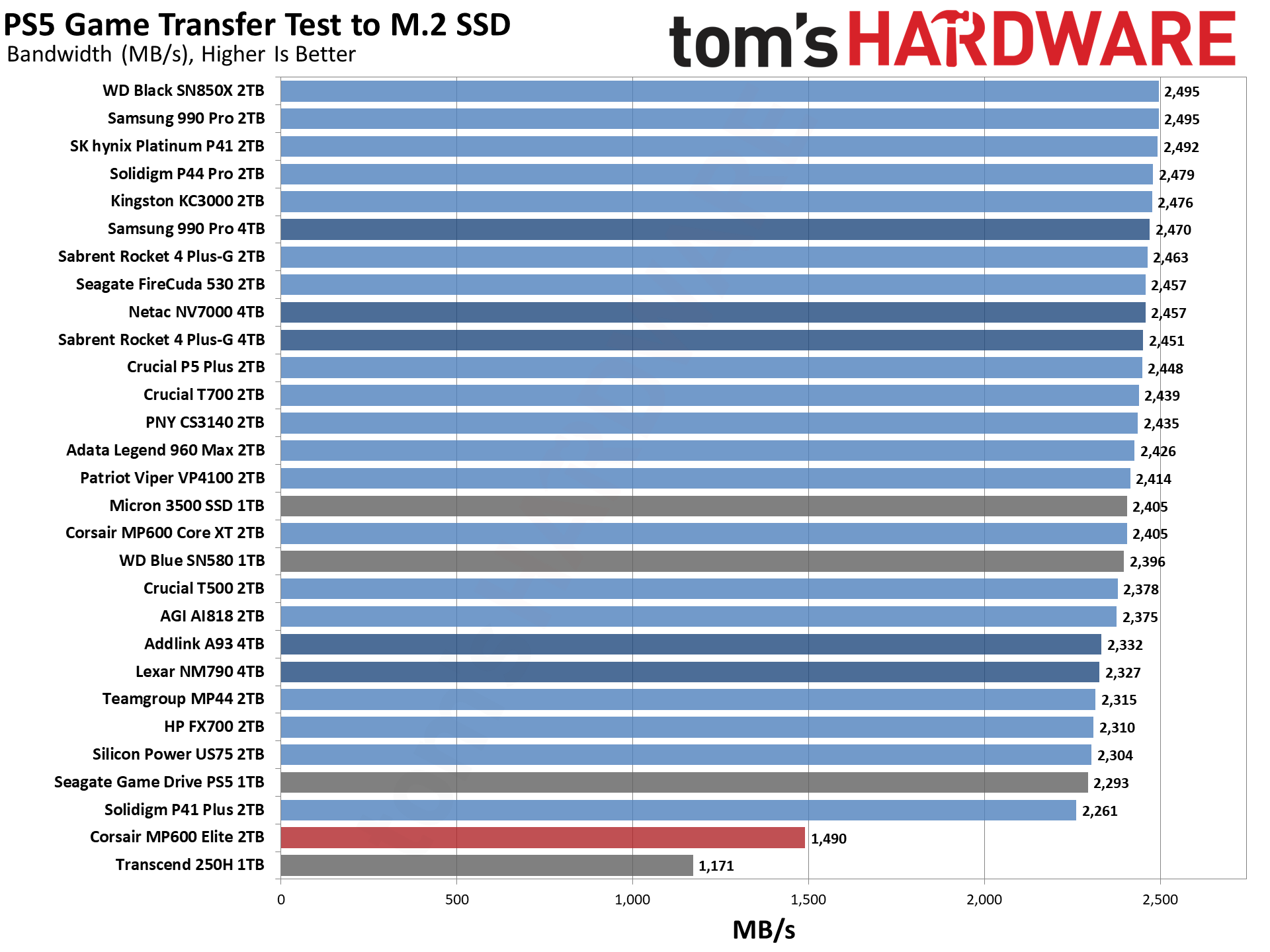
For temperature recording we currently poll the drive’s primary composite sensor during testing with a 24C ambient. Our testing is rigorous enough to heat the drive to a realistic ceiling temperature.
The MP600 Elite is quite efficient, beating out the T500 but falling behind the two MAP1602-based SSDs. These drives are all in direct competition at the upper end of budget PCIe 4.0 SSDs. The T500 uses Micron’s 232-Layer TLC, which is comparable to the 232-Layer TLC from YMTC on the MP44 and FX700, but it has a beefier controller with DRAM. The MP600 Elite’s DRAM-less controller, on the other hand, is paired with 162-Layer BiCS6 TLC, which we’ve had less of an opportunity to test. We think all of these drives score well enough to be used effectively in laptops.
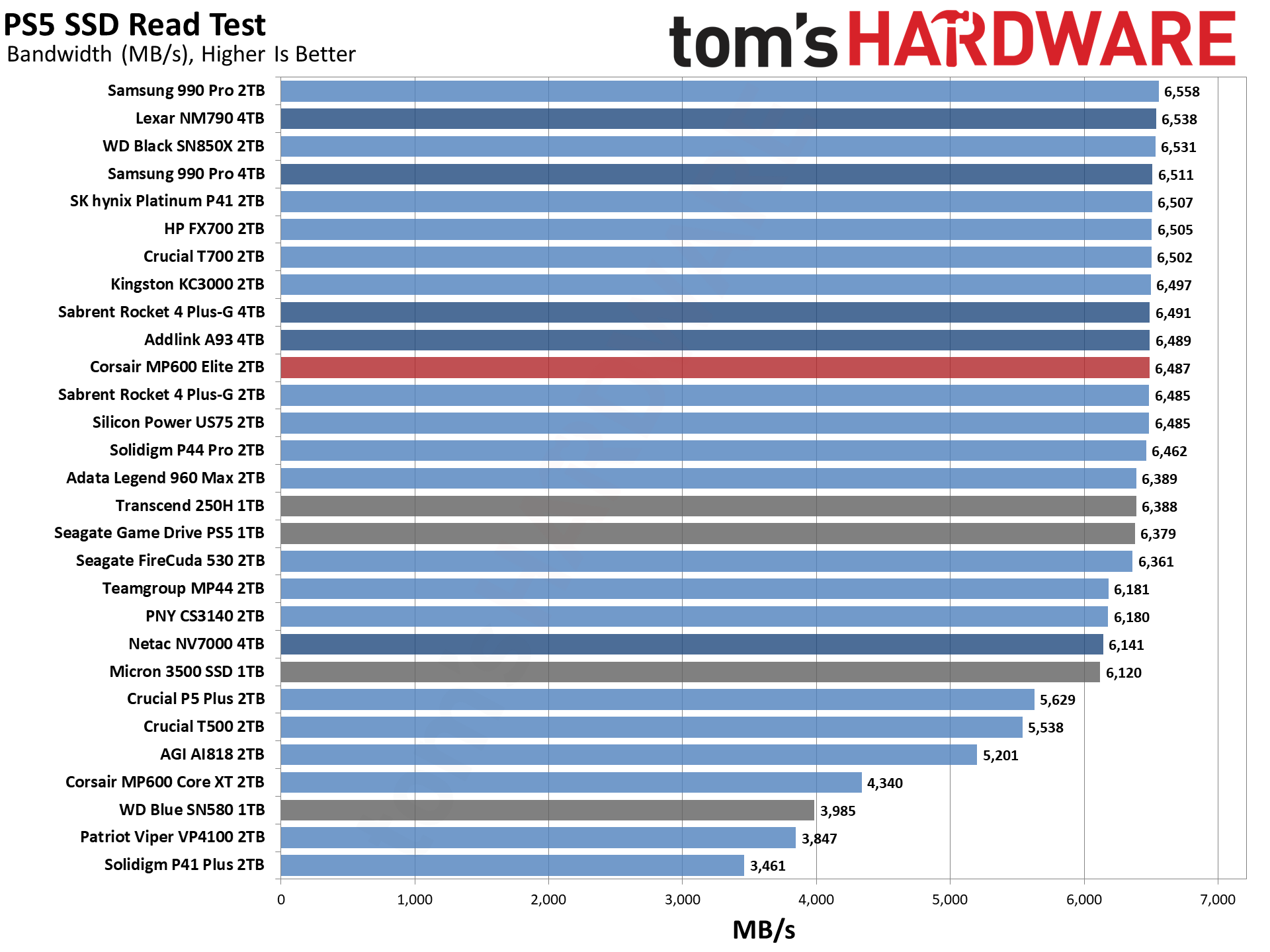
Although the MP600 Elite’s controller is rated for more watts, at 5.7W to the E21T’s 5W+ on theAddlink S90 Liteand similar drives at 2TB, it proves to be more efficient as it can finish the workload faster. The E27T and E21T are very similar controllers, but the E27T can push more bandwidth with its higher clock and other iterative improvements.
Phison does have an edge over Maxio by using a metal IHS, though, which can help with heat dissipation, and the T500’s E25 is also blessed with more surface area. A heatsink should maintain temperatures at an excellent level for any of these drives, though — specifically the MP44, FX700, T500, and MP600 Elite. The last did not exceed about 46C in our testing, but even if it gets hotter in a poor environment, it has plenty of headroom with rated throttling temperatures of 83°C and 85°C. In a laptop, we might favor the bare MP600 Elite over the MP44 and FX700 when it comes to thermals.
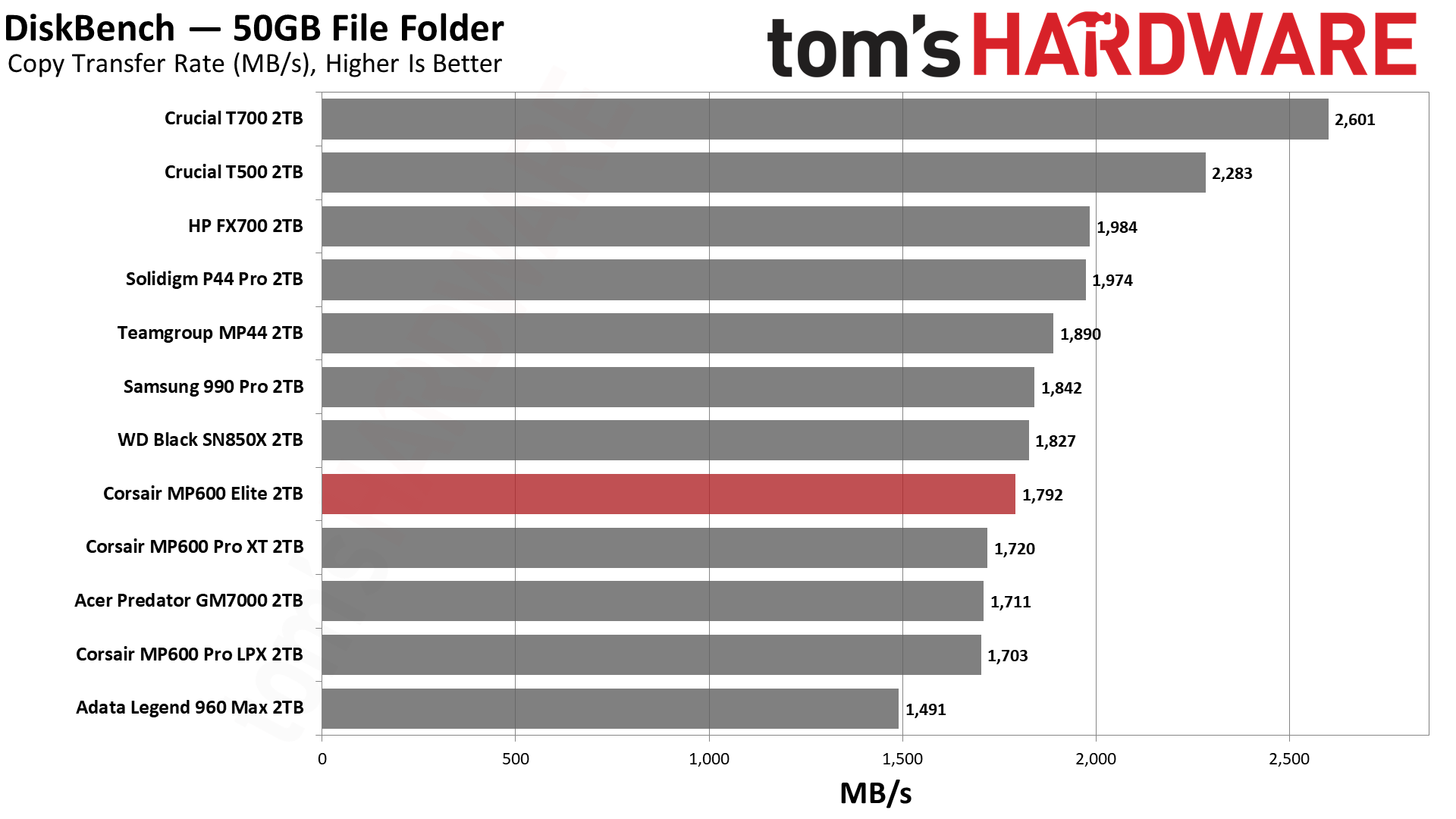
Test Bench and Testing Notes
We use an Alder Lake platform with most background applications such as indexing, Windows updates, and anti-virus disabled in the OS to reduce run-to-run variability. Each SSD is prefilled to 50% capacity and tested as a secondary device. Unless noted, we use active cooling for all SSDs.
Bottom Line
The Corsair MP600 Elite is a solid drive in its own right, providing good all-around performance and reasonable sustained performance with high power efficiency. The optional heatsink — including one that matches the PS5 — is an excellent value and is more than sufficient to keep the drive cool if you choose to go that way. This drive should be okay bare or with your own cooling solution. There’s little reason not to recommend it for a laptop, and it has the horsepower to be a main desktop drive, too.
The MP600 Elite does enter a crowded marketplace, though. There are many lingering eight-channel drives around — including several of Corsair’s within the MP600 line — that can be a bargain, and they have DRAM, too. However, the efficiency of the Elite is in its favor. While we wouldn’t put it up against the very best drives, it does hold its own against anything else. Its most direct competitors will be based on the MAP1602 or equivalent controller, such as the popular NM790. You can also get DRAM in this area with the T500, which, while not a critical factor, is something many still desire in a drive.
If we had anything bad to say about the drive, it’s that it doesn’t really stand out in any impressive way. We already have drives with newer, or at least higher layer count, flash to compete with it. Its controller feels a lot like a faster-run E21T, which is not a bad thing, but we’re still stuck on 12nm. We also have the advantage of DRAM with the T500, which forces Corsair to price this drive accordingly. If it can do that, this drive will hit all the right notes, and we can recommend it for any system.
MORE:Best External SSDs and Hard Drives
MORE:How We Test HDDs And SSDs
MORE:All SSD Content
Current page:2TB Performance Results
Shane Downing is a Freelance Reviewer for Tom’s Hardware US, covering consumer storage hardware.